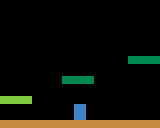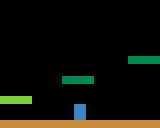[ English ]
Dernière modification le 8 juillet 2023 à 12:46
Etape 3 - Chute libre et plateformes
Introduction
Dans cette troisième étape, nous allons implémenter :
- la chute libre ;
- et la gestion des plateformes.
Chute libre
Implémentons une première version de la chute libre. En effet, nous l’adapterons après avoir ajouté les plateformes.
Dans PhysicsEngine.h, ajoutons le prototype de la fonction gravity :
void gravity(Character &aCharacter);
Implémentons la fonction gravity :
// Chute libre
void gravity(Character &aCharacter) {
const uint8_t platformId = isOnOnePlatform(aCharacter);
if( platformId == NO_ID ) {
// Chute libre
aCharacter.oldY = aCharacter.y;
aCharacter.vy += GRAVITY;
aCharacter.state = FREE_FALL_STATE;
aCharacter.y += aCharacter.vy;
} else {
// en contact avec une structure
rectifyPositionY(aCharacter);
aCharacter.vy = 0;
aCharacter.state = ON_THE_PLATFORM_STATE;
}
}
Dans le programme principal, dans l’état PLAY_STATE remplaçons gb.display.println("GRAVITY"); par gravity(hero);.
void loop() {
// boucle d'attente
gb.waitForUpdate();
// effacer l'écran
gb.display.clear();
switch(stateOfGame) {
case HOME_STATE:
stateOfGame = paintMenu();
break;
case LAUNCH_PLAY_STATE:
// ...
break;
case PLAY_STATE:
if(hero.state == ON_THE_PLATFORM_STATE) {
stateOfGame = manageCommands(hero);
}
if(hero.state != JUMP_STATE && hero.state != PUSH_FOR_JUMP_STATE) {
gravity(hero);
} else if(hero.state == JUMP_STATE || hero.state == PUSH_FOR_JUMP_STATE) {
jump(hero);
}
paint(hero);
break;
default:
gb.display.println("Votre message");
}
)
Téléversez le programme vers votre console et constatez la chute libre (en sautant sur le bord de l’écran).

Les bases de la chute libre sont maintenant implémentées, passons à la gestion des plateformes.
Les plateformes
Création des plateformes
Avant de créer la structure des plateformes, ajoutons des constantes dans Constants.h :
// Couleurs des box
// ...
const Color GROUND_COLOR = BROWN;
const Color PLATFORM_T_COLOR = LIGHTGREEN;
const Color PLATFORM_NOT_T_COLOR = GREEN;
// Nombre de plateformes
const uint8_t NB_OF_PLATFORMS = 4;
// Identifiants des plateformes
// ...
const uint8_t ID_PLATFORM_1 = 2;
const uint8_t ID_PLATFORM_2 = 3;
const uint8_t ID_PLATFORM_3 = 4;
// Type de plateformes
const uint8_t NO_PLATFORM_TYPE = 0;
const uint8_t GROUND_TYPE = 1;
const uint8_t PLATFORM_TYPE = 2;
// Pour une plateforme de 4 pixels de haut sur 8 pixels de large
const uint8_t HEIGHT_PLATFORM = 4;
const uint8_t WIDTH_PLATFORM = 8;
const uint8_t OVER_CENTER_X_PLATFORM = 4;
const uint8_t OVER_CENTER_Y_PLATFORM = 2;
// Pour le sol de 4 pixels de haut sur 8 pixels de large
const uint8_t HEIGHT_GROUND = 4;
const uint8_t WIDTH_GROUND = 8;
const uint8_t OVER_CENTER_X_GROUND = 4;
const uint8_t OVER_CENTER_Y_GROUND = 2;
Dans le fichier Platform.h, ajoutons entre autre la structure gérant les plateformes :
#ifndef PLATFORMER_PLATFORM
#define PLATFORMER_PLATFORM
#include <Gamebuino-Meta.h>
#include "Constants.h"
struct Platform {
int8_t x; // ................ position x du début de la plateforme (centre de la première plateforme)
int8_t y; // ................ position y de la plateforme (centre de la plateforme)
uint8_t lengthPlatform; // ... longueur de la plateforme en bloc (doit être au minimum égale à 2), taille des blocs dans le fichier de constantes
uint8_t type; // ............. type de plateformes : voir constantes
uint8_t id; // ............... identifiant (unique) de la plateforme
bool isGoThrough; // ......... true pour indiquer que le personnage peut passer à travers la plateforme, sinon false
};
#endif
Toujours dans Platform.h ajoutons le prototype de la fonction createPlatform qui permet de créer une plateforme :
Platform createPlatform(
int8_t aX, int8_t aY,
uint8_t aLength,
uint8_t aType,
uint8_t aId,
bool goThrough
);
Dans le fichier Platform.cpp, ajoutons la définition de la fonction createPlatform :
#include "Platform.h"
Platform createPlatform(int8_t aX, int8_t aY, uint8_t aLength, uint8_t aType, uint8_t aId, bool goThrough) {
// On force la taille de la plateforme à 2 blocs
if(aLength < 2) {
aLength = 2;
}
// On force le type de plateforme à une plateforme flottante
if(aType < 1 || aType > 2) {
aType = PLATFORM_TYPE;
}
// Création de la plateforme
Platform aPlatform;
aPlatform.x = aX;
aPlatform.y = aY;
aPlatform.lengthPlatform = aLength;
aPlatform.type = aType;
aPlatform.id = aId;
aPlatform.isGoThrough = goThrough;
return aPlatform;
}
Dans Platform.h, ajoutons le prototype de la fonction initPlatforms qui initialisera les plateformes :
void initPlatforms(Platform * aSet);
Comme vous l’avez vu dans les constantes, nous allons créer quatre plateformes, dont le sol.
Dans Platform.cpp, définissons la fonction initPlatforms :
void initPlatforms(Platform * aSet) {
aSet[0] = createPlatform(4, 62, 10, GROUND_TYPE, ID_GROUND, false);
aSet[1] = createPlatform(4, 50, 2, PLATFORM_TYPE, ID_PLATFORM_1, true);
aSet[2] = createPlatform(35, 40, 2, PLATFORM_TYPE, ID_PLATFORM_2, false);
aSet[3] = createPlatform(68, 30, 2, PLATFORM_TYPE, ID_PLATFORM_3, false);
}
Dans le programme principal, en dehors des fonctions setup et loop, ajoutons un tableau de plateformes :
// Autres includes
#include "Platform.h"
// Autres variables globales
Platform setOfPlatforms[NB_OF_PLATFORMS];
void setup() {
// ...
}
void loop() {
// ...
}
N’oubliez pas d’inclure Platform.h dans votre programme principal.
Toujours dans le programme principal, en particulier dans l’état LAUNCH_PLAY_STATE, initialisons les plateformes :
void loop() {
// boucle d'attente
gb.waitForUpdate();
// effacer l'écran
gb.display.clear();
switch(stateOfGame) {
case HOME_STATE:
stateOfGame = paintMenu();
break;
case LAUNCH_PLAY_STATE:
initPlatforms(setOfPlatforms); // ... on réinitialise les plateformes
initCharacter(hero);
stateOfGame = PLAY_STATE;
break;
case PLAY_STATE:
// ...
break;
default:
gb.display.println("Votre message");
}
}
Affichage des plateformes
Commençons par inclure Platform.h dans Display.h.
Dans Display.h, ajoutons le prototype de la fonction paintGround :
void paintGround(const int8_t aX, const int8_t aY);
Dans Display.cpp, définissons la fonction paintGround :
// Réalise l'affichage du sol
void paintGround(const int8_t aX, const int8_t aY) {
paintBox(aX, aY, WIDTH_GROUND, HEIGHT_GROUND, GROUND_COLOR);
}
Dans Display.h, ajoutons le prototype de la fonction paintPlatform qui a pour but de dessiner une plateforme flottante :
void paintPlatform(
const int8_t aX, const int8_t aY,
const bool isGoThrough
);
Dans Display.cpp, définissons la fonction paintPlatform :
// Réalise l'affichage d'une plateforme flottante
void paintPlatform(const int8_t aX, const int8_t aY, const bool isGoThrough) {
paintBox(aX, aY, WIDTH_PLATFORM, HEIGHT_PLATFORM, (isGoThrough ? PLATFORM_T_COLOR : PLATFORM_NOT_T_COLOR));
}
Dans Display.h, ajoutons le prototype de la fonction paintPlatform qui oriente vers la fonction de dessin dédiée :
void paintPlatform(const Platform &aPlatform);
Dans Display.cpp, définissons la fonction paintPlatform :
// Oriente vers la fonction de dessin dédiée
void paintPlatform(const Platform &aPlatform) {
int8_t x = aPlatform.x - OVER_CENTER_X_PLATFORM;
int8_t y = aPlatform.y - OVER_CENTER_Y_PLATFORM;
switch(aPlatform.type) {
case GROUND_TYPE:
x = aPlatform.x - OVER_CENTER_X_GROUND;
y = aPlatform.y - OVER_CENTER_Y_GROUND;
break;
}
for(uint8_t i = 0 ; i < aPlatform.lengthPlatform ; i++) {
switch(aPlatform.type) {
case GROUND_TYPE:
paintGround(x, y);
x += WIDTH_GROUND;
break;
default:
paintPlatform(x, y, aPlatform.isGoThrough);
x += WIDTH_PLATFORM;
}
}
}
Dans Display.h, ajoutons le prototype de la fonction paintPlatforms qui dessine toutes les plateformes :
void paintPlatforms(Platform * aSet);
Dans Display.cpp, définissons la fonction paintPlatforms :
// Dessine toutes les plateformes
void paintPlatforms(Platform * aSet) {
for(int i = 0 ; i < NB_OF_PLATFORMS ; i++) {
paintPlatform(aSet[i]);
}
}
Dans Display.h, modifions le prototype de la fonction paint tel que :
void paint(Character &aCharacter, Platform * aSetOfPlatforms);
Dans Display.cpp, modifions la définition de la fonction paint :
void paint(Character &aCharacter, Platform * aSetOfPlatforms) {
paintPlatforms(aSetOfPlatforms);
// dessiner le personnage...
}
Dans le programme principal, modifions l’appel de la méthode paint tel que :
void loop() {
// boucle d'attente
gb.waitForUpdate();
// effacer l'écran
gb.display.clear();
switch(stateOfGame) {
case HOME_STATE:
stateOfGame = paintMenu();
break;
case LAUNCH_PLAY_STATE:
// ...
break;
case PLAY_STATE:
// ...
paint(hero, setOfPlatforms);
break;
default:
gb.display.println("Votre message");
}
)
Avant de rendre nos plateformes “physiques”, nous allons modifier la position de notre personnage pour qu’il s’affiche au dessus du sol.
Dans Character.cpp, modifions la fonction initCharacter, en particulier la position y tel que :
void initCharacter(Character &aCharacter) {
// on force la position intiale du héro au milieu de l'écran et plaqué au sol
aCharacter.x = 40;
aCharacter.y = gb.display.height() - (UNDER_CENTER_Y_HERO + HEIGHT_GROUND);
// ...
}
Toujours dans Character.cpp, modifions la fonction rectifyPositionY tel que :
void rectifyPositionY(Character &aCharacter) {
aCharacter.y = (gb.display.height() - (UNDER_CENTER_Y_HERO + HEIGHT_GROUND));
}
Enfin, dans PhysicsEngine.cpp, modifions la fonction isOnOnePlatform tel que :
const uint8_t isOnOnePlatform(const Character &aCharacter) {
return ( (aCharacter.y + aCharacter.vy) >= (gb.display.height() - (UNDER_CENTER_Y_HERO + HEIGHT_GROUND)) ) ? ID_GROUND : NO_ID ;
}
Vous pouvez téléverser le programme vers votre console. Vous verrez que votre personnage est dessiné sur le sol, par contre vous pouvez sauter sur les plateformes, mais aucune réaction, vous les traversez. Nous allons y remédier tout de suite.

Collision avec les plateformes
Pour commencer, nous avons besoin d’une fonction qui indique si le personnage monte ou descend.
Dans Character.h, ajoutons le prototype de la fonction isFall :
bool isFall(const Character &aCharacter);
Dans Character.cpp, définissons la fonction isFall :
// true si le personnage descend, false sinon
bool isFall(const Character &aCharacter) {
return (aCharacter.oldY - aCharacter.y) < 0;
}
Nous allons également avoir besoin d’une fonction qui retourne la plateforme correspondante à l’identifiant donné en paramètre.
Dans Platform.h, ajoutons le prototype de la fonction getPlatformFromId :
Platform getPlatformFromId(const uint8_t aId, Platform * aSet);
Dans Platform.cpp, définissons la fonction getPlatformFromId :
Platform getPlatformFromId(const uint8_t aId, Platform * aSet) {
for(uint8_t i = 0 ; i < NB_OF_PLATFORMS ; i++) {
if(aSet[i].id == aId) {
return aSet[i];
}
}
Platform nullPlatform;
nullPlatform.id = NO_ID;
return nullPlatform;
}
Ajoutons une fonction qui détermine s’il y a une collision avec la plateforme fournit en paramètre.
Dans PhysicsEngine.h, ajoutons le prototype de la fonction isOnThePlatform, il est nécessaire d’inclure Platform.h dans PhysicsEngine.h :
const uint8_t isOnThePlatform(
const Character &aCharacter,
const Platform &aPlatform
);
Dans PhysicsEngine.cpp, définissons la fonction isOnThePlatform :
// Détecter si une collision à lieu avec la plateforme en paramètre
const uint8_t isOnThePlatform(const Character &aCharacter, const Platform &aPlatform) {
int8_t xCharacter = aCharacter.x - OVER_CENTER_X_HERO;
int8_t yCharacter = aCharacter.y - OVER_CENTER_Y_HERO;
int8_t xPlatform = aPlatform.x - OVER_CENTER_X_PLATFORM;
int8_t yPlatform = aPlatform.y - OVER_CENTER_Y_PLATFORM;
uint8_t widthPlatform = WIDTH_PLATFORM;
uint8_t heightPlatform = HEIGHT_PLATFORM;
switch(aPlatform.type) {
case GROUND_TYPE:
xPlatform = aPlatform.x - OVER_CENTER_X_GROUND;
yPlatform = aPlatform.y - OVER_CENTER_Y_GROUND;
widthPlatform = WIDTH_GROUND;
heightPlatform = HEIGHT_PLATFORM;
break;
}
if(aCharacter.state == JUMP_STATE && !isFall(aCharacter) && aPlatform.isGoThrough) {
// Si l'on saute, que l'on monte et que la plateforme peut être traversé
// alors on ne déclenche pas la détection de collision
return NO_ID;
} else if(
aCharacter.state == JUMP_STATE &&
gb.collideRectRect(xCharacter, yCharacter + aCharacter.vy, WIDTH_HERO, HEIGHT_HERO, xPlatform, yPlatform, widthPlatform * aPlatform.lengthPlatform, heightPlatform)
)
{
return aPlatform.id;
} else {
if( (aCharacter.y + UNDER_CENTER_Y_HERO + aCharacter.vy) >= yPlatform ) {
return gb.collideRectRect(xCharacter, yCharacter + aCharacter.vy, WIDTH_HERO, HEIGHT_HERO, xPlatform, yPlatform - 1, widthPlatform * aPlatform.lengthPlatform, heightPlatform) ? aPlatform.id : NO_ID;
}
}
return NO_ID;
}
Dans PhysicsEngine.h, modifions le prototype de la fonction isOnOnePlatform afin de lui passer un ensemble de plateformes en paramètre, soit :
const uint8_t isOnOnePlatform(
const Character &aCharacter,
Platform * aSetOfPlatforms
);
Modifions le code de la fonction isOnOnePlatform (dans PhysicsEngine.cpp) :
// Permet de détecter une collision avec une plateforme
const uint8_t isOnOnePlatform(const Character &aCharacter, Platform * aSetOfPlatforms) {
for(uint8_t i = 0 ; i < NB_OF_PLATFORMS ; i++) {
const uint8_t platformId = isOnThePlatform(aCharacter, aSetOfPlatforms[i]);
if(platformId != NO_ID) {
return platformId;
}
}
return NO_ID ;
}
Comme vous pouvez le remarquer, la fonction isOnOnePlatform parcourt l’ensemble des plateformes, et si elle détecte une collision alors elle renvoie l’identifiant de la plateforme avec laquelle le personnage est en collision.
Apportons maintenant une modification à la fonction rectifyPositionY, nous allons lui ajouter un paramètre, qui sera une plateforme, afin de corriger la position y en fonction de la plateforme avec laquelle le joueur est en contact.
Il est nécessaire d’inclure Platform.h dans Character.h.
Dans Character.h, modifions le prototype de la fonction rectifyPositionY :
void rectifyPositionY(Character &aCharacter, Platform &aPlatform);
Et adaptons le code de la fonction rectifyPositionY :
// Corriger la position y
void rectifyPositionY(Character &aCharacter, Platform &aPlatform) {
int8_t overCenterY = OVER_CENTER_Y_PLATFORM;
switch(aPlatform.type) {
case GROUND_TYPE:
overCenterY = OVER_CENTER_Y_GROUND;
break;
}
aCharacter.y = (aPlatform.y - (UNDER_CENTER_Y_HERO + overCenterY));
}
Adaptons la fonction gravity.
Dans PhysicsEngine.h, modifions le prototype de la fonction gravity tel que :
void gravity(Character &aCharacter, Platform * aSetOfPlatforms);
Dans PhysicsEngine.cpp, modifions la fonction gravity tel que :
// Chute libre
void gravity(Character &aCharacter, Platform * aSetOfPlatforms) {
const uint8_t platformId = isOnOnePlatform(aCharacter, aSetOfPlatforms);
if( platformId == NO_ID ) {
/* ... */
} else {
Platform aPlatform = getPlatformFromId(platformId, aSetOfPlatforms);
rectifyPositionY(aCharacter, aPlatform);
/* ... */
}
}
De la même mannière, modifions le prototype de la fonction jump, dans PhysicsEngine.h, tel que :
void jump(Character &aCharacter, Platform * aSetOfPlatforms);
Dans PhysicsEngine.h, modifions la fonction jump :
// Implémentation du saut du personnage
void jump(Character &aCharacter, Platform * aSetOfPlatforms) {
const uint8_t platformId = isOnOnePlatform(aCharacter, aSetOfPlatforms);
if(aCharacter.state == PUSH_FOR_JUMP_STATE) {
/* Inchangé... */
} else if( platformId != NO_ID) {
// Si on est en contact avec une plateforme
Platform aPlatform = getPlatformFromId(platformId, aSetOfPlatforms);
if(aPlatform.isGoThrough || (isFall(aCharacter) && aCharacter.y <= aPlatform.y) || aPlatform.type == GROUND_TYPE) {
rectifyPositionY(aCharacter, aPlatform);
aCharacter.vy = 0;
aCharacter.state = ON_THE_PLATFORM_STATE;
} else {
aCharacter.vy = 0;
jumpMovement(aCharacter);
}
} else if( isOutOfWorld(aCharacter) ) {
/* Inchangé... */
} else {
/* Inchangé... */
}
}
Enfin, dans le programme principal, apportons quelques modifications dans le code correspondant à l’état PLAY_STATE :
void loop() {
// boucle d'attente
gb.waitForUpdate();
// effacer l'écran
gb.display.clear();
switch(stateOfGame) {
case HOME_STATE:
stateOfGame = paintMenu();
break;
case LAUNCH_PLAY_STATE:
// ...
break;
case PLAY_STATE:
if(hero.state == ON_THE_PLATFORM_STATE) {
stateOfGame = manageCommands(hero);
}
if(hero.state != JUMP_STATE && hero.state != PUSH_FOR_JUMP_STATE) {
gravity(hero, setOfPlatforms);
} else if(hero.state == JUMP_STATE || hero.state == PUSH_FOR_JUMP_STATE) {
jump(hero, setOfPlatforms);
}
paint(hero);
break;
default:
gb.display.println("Votre message");
}
)
Téléversez votre porgramme vers la console, et amusez-vous à sauter sur les plateformes. Si vous avez conserver les valeurs fournies dans cette étape, autant les couleurs que la position des plateformes, vous pouvez être en-dessous de la plateforme verte claire et sauter, pour ainsi monter dessus.

Conclusion
Vous voici arrivé à la fin de cette troisième étape : où nous avons ajouté la chute libre et la gestion des plateformes.
Dans la prochaine étape, c’est-à-dire la quatrième, nous aborderons les interactions avec le monde. Nous allons ainsi voir comment ajouter des objets comme des clés et une porte.
N’hésitez pas à me faire un retour : les améliorations que vous apporteriez (un regard extérieur est toujours bienvenu), les choses que vous n’avez pas compris, les fautes, etc. Pour laisser un retour, merci d’ajouter un commentaire à la création suivante :
Lire la suite ››